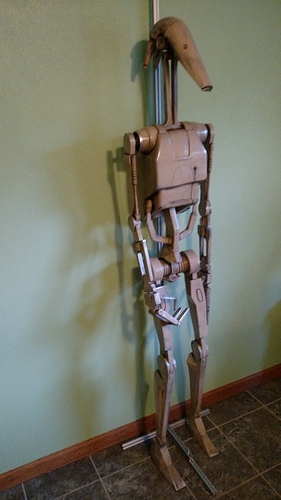A question that I’ve wondered but never found an answer to. How thin of a layer can we print. I understand this is a bit of a Pandora’s box type question so I’ll steer the conversation a bit from the start.
I work only with ABS right now to meet specific needs and many parts are large. The smaller the layer height, the longer it takes to print, but it has a major benefit of reducing layer separation and warping.
Running 1/8° nema 17 (80oz) at 1/16 micro stepping on SD8825 drivers.
2mm/rev trapezoidal lead screws from Roton.
That puts me at 1600 steps/mm in Z.
16 tooth gt2 puts me at 100 steps/mm in x and y.
My extruder is direct drive hobbed. Calibrated around 100 steps/mm and 96% on the multiplier.
The extrusion rate jumps out as a primary consideration.
The E3D V5 with a .4mm nozzle should keep up just fine.
So how do I proceed to determine the absolute lowest layer height?
(The pic is for attention and relevance. I did the battle droid at .1 and .2mm layer heights. Some parts of things like this are fine for .1/.2 but plenty of bits would be nice to do thinner.)
Looking at the prusa calculator, I input my settings to calculate the optimal layer height. For .1mm it says 10 steps at .01mm step height. If I’m reading into this right, that means I can do 0.01mm layer height.
Can anyone confirm this?
Some information here: http://richrap.blogspot.no/2012/01/slic3r-is-nicer-part-3-how-low-can-you.html
I’ve done 0.05mm outer perimeters with thicker (0.2mm) infill myself, with no issues.
Just try it out 
That’s the effective resolution of your z axis (to make a long story short, anyway), but the resolution and jam-resistance of your extruder makes more difference to your actual minimum achievable layer height than your z steps. Printing thinner layers also means longer prints, so your printer’s mean time to failure also needs to be considered.
I’m throwing some new parts in the printer tonight so I hope to do some serious testing over the next few days.
Thanks for the feedback
@Andrew_Radovich_BadW : where did you get the STLs for the battle droid?
As @Whosa_whatsis said at those super how levels your head pressure in the nozzle is much higher. In the things that I have done I’ve found that I not only gained time in number of layers printed but I also had to print much slower to accommodate the pressure and not strip out filament.
I’ve gone down to .03mm on the lulzbot taz4 with a wades extruder and 3mm pla.
Pressure is lower when you extrude faster, not higher. Friction maybe higher though, because slowly moving plastic is more prone to heat creep than fast-moving plastic.
If you use a thinner nozzle, gear reduction, and a thinner filament I would guess quite small… But the return on investment is small below .1mm and even .1 isn’t that much better than .3
There’s resolution and then there’s accuracy. Unless all your bearings are that good and your carriage has negligible deflection and your hot section doesn’t change length at all under temperature cycling, and your filament is incredibly uniform in both diameter and properties, you’re going to get only a rough approximation of what you specified.
That look more like a Gungan than a battle droid… 
I didn’t get a chance to finish the part swap on my printer last night, so maybe I can do some testing tonight.
@Camerin_hahn , remember that resolution of the print is not my only goal with thin layers. The 0.1mm layer height allows ABS to bond/cool/shrink before the next layer is applied. My guess is a .07 or .05 will be my optimal height for big parts that I don’t want warping.
@Andrew_Radovich_BadW realize that the heat transfer to the print from the brass nozzle will also cause warping… There will be diminished returns at some point… You are re softening the print more times with more layers.
Dialed in at .1mm so far. I had a bed clamp issue to sort out and I took the time to really align the z rails. Next I’ll try .05


